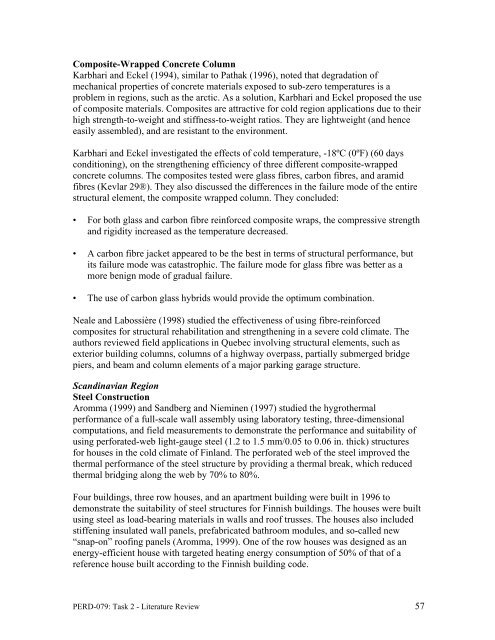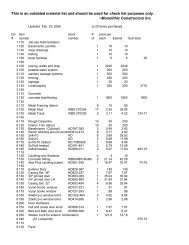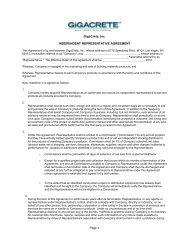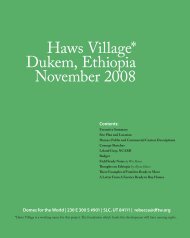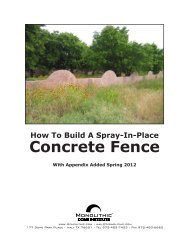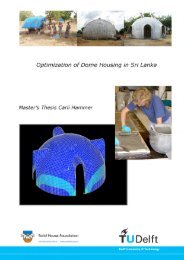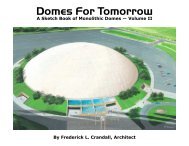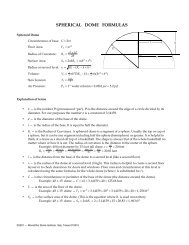Literature Review on Building Envelope, Heating and ... - Beeshive.org
Literature Review on Building Envelope, Heating and ... - Beeshive.org
Literature Review on Building Envelope, Heating and ... - Beeshive.org
You also want an ePaper? Increase the reach of your titles
YUMPU automatically turns print PDFs into web optimized ePapers that Google loves.
Composite-Wrapped C<strong>on</strong>crete Column<br />
Karbhari <strong>and</strong> Eckel (1994), similar to Pathak (1996), noted that degradati<strong>on</strong> of<br />
mechanical properties of c<strong>on</strong>crete materials exposed to sub-zero temperatures is a<br />
problem in regi<strong>on</strong>s, such as the arctic. As a soluti<strong>on</strong>, Karbhari <strong>and</strong> Eckel proposed the use<br />
of composite materials. Composites are attractive for cold regi<strong>on</strong> applicati<strong>on</strong>s due to their<br />
high strength-to-weight <strong>and</strong> stiffness-to-weight ratios. They are lightweight (<strong>and</strong> hence<br />
easily assembled), <strong>and</strong> are resistant to the envir<strong>on</strong>ment.<br />
Karbhari <strong>and</strong> Eckel investigated the effects of cold temperature, -18ºC (0ºF) (60 days<br />
c<strong>on</strong>diti<strong>on</strong>ing), <strong>on</strong> the strengthening efficiency of three different composite-wrapped<br />
c<strong>on</strong>crete columns. The composites tested were glass fibres, carb<strong>on</strong> fibres, <strong>and</strong> aramid<br />
fibres (Kevlar 29®). They also discussed the differences in the failure mode of the entire<br />
structural element, the composite wrapped column. They c<strong>on</strong>cluded:<br />
• For both glass <strong>and</strong> carb<strong>on</strong> fibre reinforced composite wraps, the compressive strength<br />
<strong>and</strong> rigidity increased as the temperature decreased.<br />
• A carb<strong>on</strong> fibre jacket appeared to be the best in terms of structural performance, but<br />
its failure mode was catastrophic. The failure mode for glass fibre was better as a<br />
more benign mode of gradual failure.<br />
• The use of carb<strong>on</strong> glass hybrids would provide the optimum combinati<strong>on</strong>.<br />
Neale <strong>and</strong> Labossière (1998) studied the effectiveness of using fibre-reinforced<br />
composites for structural rehabilitati<strong>on</strong> <strong>and</strong> strengthening in a severe cold climate. The<br />
authors reviewed field applicati<strong>on</strong>s in Quebec involving structural elements, such as<br />
exterior building columns, columns of a highway overpass, partially submerged bridge<br />
piers, <strong>and</strong> beam <strong>and</strong> column elements of a major parking garage structure.<br />
Sc<strong>and</strong>inavian Regi<strong>on</strong><br />
Steel C<strong>on</strong>structi<strong>on</strong><br />
Aromma (1999) <strong>and</strong> S<strong>and</strong>berg <strong>and</strong> Nieminen (1997) studied the hygrothermal<br />
performance of a full-scale wall assembly using laboratory testing, three-dimensi<strong>on</strong>al<br />
computati<strong>on</strong>s, <strong>and</strong> field measurements to dem<strong>on</strong>strate the performance <strong>and</strong> suitability of<br />
using perforated-web light-gauge steel (1.2 to 1.5 mm/0.05 to 0.06 in. thick) structures<br />
for houses in the cold climate of Finl<strong>and</strong>. The perforated web of the steel improved the<br />
thermal performance of the steel structure by providing a thermal break, which reduced<br />
thermal bridging al<strong>on</strong>g the web by 70% to 80%.<br />
Four buildings, three row houses, <strong>and</strong> an apartment building were built in 1996 to<br />
dem<strong>on</strong>strate the suitability of steel structures for Finnish buildings. The houses were built<br />
using steel as load-bearing materials in walls <strong>and</strong> roof trusses. The houses also included<br />
stiffening insulated wall panels, prefabricated bathroom modules, <strong>and</strong> so-called new<br />
“snap-<strong>on</strong>” roofing panels (Aromma, 1999). One of the row houses was designed as an<br />
energy-efficient house with targeted heating energy c<strong>on</strong>sumpti<strong>on</strong> of 50% of that of a<br />
reference house built according to the Finnish building code.<br />
PERD-079: Task 2 - <str<strong>on</strong>g>Literature</str<strong>on</strong>g> <str<strong>on</strong>g>Review</str<strong>on</strong>g> 57


